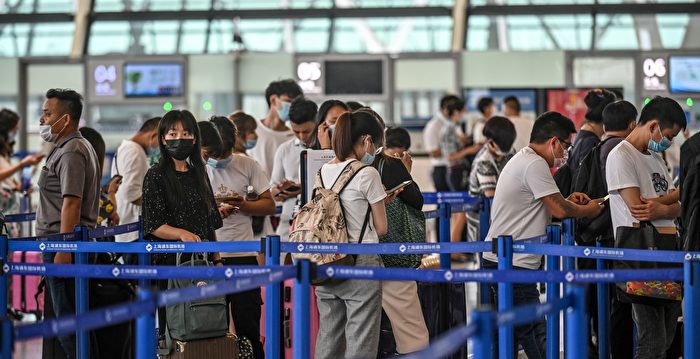[Epoch Times, August 17, 2021]After the U.S. government partially liberalized the restrictions on foreign students going to the United States, the current Beijing and Shanghai flights to the U.S. are “full,” and the time for Chinese students to queue at the airport has been extended.
China Business News reported on August 16 that yesterday, a photo was widely circulated on the Internet, saying that after the United States opened up the entry of foreign students, Chinese students queued up at Shanghai Pudong Airport to check in to the United States. Some flights were waiting for check-in and see off. The team is kilometers long.
A personal report from another see-off person even mentioned that the line began to wait for check-in at around 9 in the morning, and the boarding pass was not received until around 1 in the afternoon.
Since August 1, the United States has lifted the restrictions on foreign students going to the United States. Students holding F/M visas will no longer be affected by the “entry to the United States ban” and can go directly to the United States from China without transiting to a third country.14 sky.
It is understood that there is indeed a strong demand for flights from Beijing and Shanghai to the United States via Hong Kong. Airport check-in time and queues are indeed very long. One is that a student may have several parents accompanied to check-in at the airport. In addition, the epidemic During the check-in period, the documents required to be submitted are also a lot more than usual.
At the same time, due to the temporary closure of Nanjing Airport after the outbreak of the local epidemic, international flights from Nanjing were also suspended. Passengers who originally chose to fly abroad from Nanjing also chose Pudong Airport to depart, which also caused a further increase in Pudong Airport passengers.
The short supply of China-US routes has also brought about soaring fares. It is understood that in July, if you transfer from mainland China to the United States via Hong Kong, you can still buy 5,000-8,000 yuan in economy class, and about 16,000 yuan in business class. In August, the economy class ticket has risen to 2~2. 30,000 yuan, and the business class is even more than 70,000 to 100,000 yuan.
On April 30 this year, the Consul General of the Consular Section of the US Embassy in China, William Bistransky, stated that the US embassies in China will open some face-to-face visas on May 4, 2021. Chinese students studying in the United States can apply within 120 days before the start of the course. Visa, but can only enter the United States 30 days in advance at the earliest. However, students who are involved in China’s military-civilian integration strategy and certain high-tech fields have difficulty applying for visas or have to undergo “additional investigations.”
The WeChat public account “Study Abroad Daily” issued a so-called “convening order” in mid-June this year. The “convening order” called on Chinese students who were refused visas to stay in the United States to be in Sanyuan, Chaoyang District, Beijing at 18:00 on July 1, 2021. Assembly at No. 55, Jialou Road, Qiao’an (in front of the US Embassy in China) to protest the US government’s refusal of visas for Chinese students.
On May 29, 2020, the then-U.S. President Trump (Trump) signed Presidential Decree No. 10043, suspending and restricting Chinese students who have ties to the Chinese Communist Party’s military from obtaining F and J visas.
After this presidential decree came into effect, many undergraduates who graduated from specific universities, such as the “Seven National Defense” universities directly under the Ministry of Industry and Information Technology of the Chinese Communist Party, were affected. Rejected or cancelled, the affected majors also include liberal arts and business. In September of that year, US officials stated that they had cancelled the visas of more than 1,000 Chinese citizens under this order.
From the 2020 to 2021 academic year, about 370,000 Chinese students are studying in American schools, which is the largest source of international students in the United States, of which about 42% are studying science and engineering.
Editor in charge: Li Jing#
.
